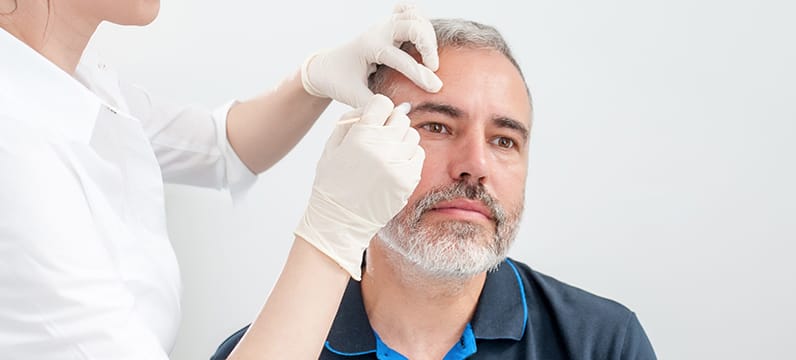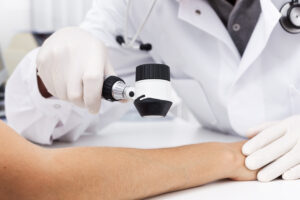Mohs Micrographic Surgery in South Miami
What is Mohs surgery?
Mohs surgery is a treatment option for skin cancer, during which the cancerous cells are removed, one layer at a time, during an outpatient procedure. Initially developed by Dr. Frederic Mohs approximately 50 years ago, the procedure is commonly referred to as “Mohs surgery” although it is also known as chemosurgery, microscopically controlled surgery or histographic surgery. Mohs micrographic surgery differs from conventional surgical removal of skin cancers because it relies on microscopic evaluation of the borders of the portion of skin that is removed during the procedure. This ensures that no residual skin cancer cells are left behind. Mohs surgery is one of the most effective techniques available today to remove skin cancer while sparing surrounding healthy cells. At the Skin Center of South Miami, our dermatologists are experts in the Mohs procedure with years of experience diagnosing and treating skin cancer.
Why is Mohs micrographic surgery used?
Mohs surgery is usually used when a skin cancer is present and:
- Large
- Recurring
- In a hard-to-reach area
- In an area where skin preservation is important (e.g. the facial region)
What does Mohs surgery involve?
Before Mohs Surgery
Prior to undergoing Mohs surgery at the Skin Center of South Miami, one of our trained surgeons will numb the area using a local anesthetic so you will feel little discomfort during the procedure. Then, your surgeon will remove the cancerous skin cells by carefully taking one layer tissue at a time. Each thin layer of skin tissue is examined by your surgeon to check for cancerous cells, and the layer removal process is stopped once a cancer-free layer is examined. The entire procedure can be done during one office visit and has a very high success rate.
When you arrive for your appointment, a surgical assistant will escort you to a treatment room and prepare you for your procedure. You will be given a consent form to read and sign authorizing the surgeon to surgically remove your skin cancer. At this time, you are invited to ask any additional questions about the procedure and to communicate any concerns to the doctor.
During Mohs Surgery
Once you are comfortable with the doctor’s treatment plan, you will be positioned in the surgical chair in preparation for surgery. After confirming the exact site of the skin cancer to be removed, the surgeon will use a local anesthetic to numb the area. The skin cancer will then be surgically removed and immediately sent to the laboratory located inside of our facility. The surgical area will then be covered with a temporary bandage and you will be escorted to a waiting area where you can relax while the removed tissue is being processed and examined by the surgeon. If the surgeon confirms that all of the skin cancer has been removed, you will be brought back into the surgical room and the treated area will be sutured closed. If, however, the surgeon determines that the skin cancer has not yet been completely removed, you will be brought back into the surgical room where a second portion of tissue will be removed. You will be given another temporary bandage while the second portion of tissue is processed and examined in the laboratory while you again wait comfortably in the waiting area. The same sequence of events will be repeated until all of the skin cancer has been completely removed.
After Mohs Surgery
Once the skin cancer is all out and your surgical site has been sutured closed, you will be given a final bandage that should be left on for two days, unless your doctor tells you otherwise. Sometimes special bandages are applied that must remain in place for longer or shorter periods of time so you should confirm this with your doctor. After removing your bandage, you should follow the wound care instructions provided following your procedure. Before you leave the office, a follow-up appointment will be scheduled to assess your healing and to remove your sutures.
Frequently Asked Questions About Mohs Surgery for Skin Cancer
How big will the surgical area be?
Unfortunately, it is not possible to predict the final size of your Mohs surgical area. Some skin cancers are very small while others may be much larger. Even skin cancers that appear very tiny may actually be found to be larger once the surgery begins. Sometimes, the visible part of a skin cancer is like the top of an iceberg, with the largest part detected only after the Mohs procedure is underway. Occasionally, very large areas may need to be removed in order to completely clear out the skin cancer from the skin. This can sometimes result in permanent changes in the appearance of cosmetically sensitive parts of the face, such as the ear or nose if a skin cancer extends widely into these areas.
Will I have a scar after Mohs surgery?
Scar formation is part of the normal healing process following Mohs surgery. Every surgery that involves your skin results in a scar. Fortunately, the skin usually heals quickly and well. Many very large surgical procedures often heal so well that the resultant scarring is very hard to see. However, everybody heals differently and some people tend to develop large scars, even after minor cuts or scrapes. This simply cannot be avoided in susceptible people. If you know that you always heal poorly and tend to develop very noticeable scars, you should discuss any concerns with your surgeon before surgery. You may wish to select a nonsurgical form of treatment if available for your type of skin cancer or you may wish to have a plastic surgeon assist with the final stages of surgery.
How can I prepare for Mohs surgery?
Follow the below steps before your surgery to ensure a seamless procedure:
- Eat a full breakfast since you may be required to remain in the office for a good portion of the day.
- Take all of your required medications.
- Take antibiotics one hour before your surgery if you have a joint replacement(s), heart valve condition, organ transplant, or for other medical reasons if required or recommended by one of your doctors.
- Tell your surgeon if you have a pacemaker or implanted cardiac defibrillator or any other implanted electronic device.
- Bring a designated driver with you in case you feel unable to drive yourself home after surgery.
- Bring a list of all of your current medications, allergies to medicines, and a list of all of your medical conditions to review with the surgeon before treatment.
- Tell your surgeon if you are allergic to any anesthetic or if you have had any previous reactions to epinephrine such as palpitations or any other side effect.
- Since aspirin or aspirin-containing medications (Ecotrin, Anacin, Alka Seltzer) can prolong bleeding, ask your general medical doctor, cardiologist, neurologist or another doctor who prescribed it if you can safely discontinue your aspirin regimen one week before and two days after your procedure. In order to prevent serious health risks, always ask your prescribing doctor before discontinuing any medication.
- Inform your surgeon about any other medicines that you are taking that may prolong bleeding such as Coumadin or Plavix. Since these medicines were prescribed to you for serious medical conditions, do not stop taking them unless your prescribing doctor recommends that you do so.
- It is recommended to stop taking all non-aspirin pain relievers such as Advil, Aleve, Motrin, ibuprofen or others at least 4 days before surgery unless the doctor that recommended them wants you to continue. Tylenol is OK.
- Do not drink alcoholic beverages 2 days before your surgery.
- Do not take herbal supplements that may cause bleeding such as Vitamin E, ginkgo biloba, garlic, alfalfa, capsicum, celery, chamomile, herbal teas, danshen, dong quai, echinacea, fenugreek, feverfew, fish oil, flax seed oil, ginger, ginseng, green tea, horseradish, huang qui, kava kava, licorice, passion flower and red clover, for 10 days before and 7 days after surgery.
What are the benefits of visiting the Skin Center of South Miami for Mohs surgery?
There are numerous advantages to undergoing Mohs surgery under the care of our Mohs surgeons at the Skin Center of South Miami. These include the following:
- One of the most effective forms of skin cancer surgery
- Allows for the removal of the least amount of normal tissue
- May be less problematic than other techniques in cosmetically sensitive areas (e.g. face, ears, scalp, nose, neck, hands and feet)
- Unparalleled cure rate
- Can often rid a person of recurring cancers
Schedule Your Consultation Today
If you are interested in learning more about Mohs micrographic surgery, contact our experienced dermatologists at the Skin Center of South Miami. Our providers are experts when it comes to skin exams, early cancer detection, and the most advanced skin cancer procedures. Our team is dedicated to delivering personalized dermatology care for every patient, no matter how complex your condition is. Call us at 305-740-6181 or fill out the form on this page to schedule a consultation today.

